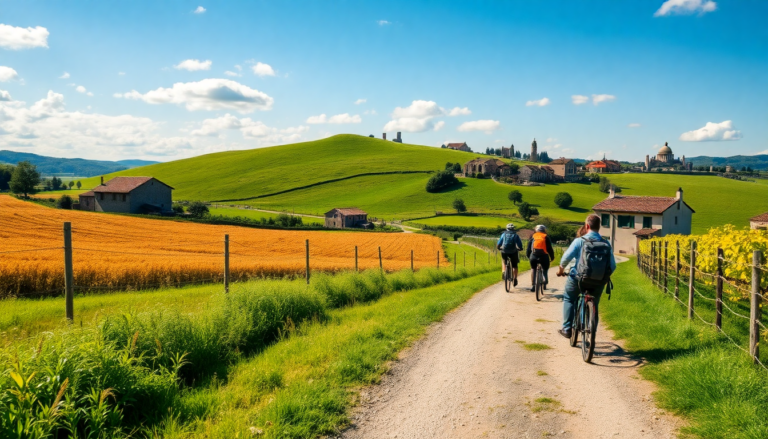Argomenti trattati
The Via Postumia is more than just a trail; it’s a vibrant tapestry of history, culture, and natural beauty that stretches over 900 kilometers from Aquileia to Genoa. Originally built as a Roman consular road in 148 BC, this ancient pathway now attracts hikers, pilgrims, and slow travel enthusiasts eager to explore the rich heritage of northern Italy. As you walk or cycle along this historic route, you’ll encounter charming villages, breathtaking landscapes, and a variety of cultural landmarks that tell the story of a land steeped in tradition.
The historical significance of the Via Postumia
Constructed under the leadership of the Roman consul Spurius Postumius Albinus, the Via Postumia served as a vital link between the Adriatic and Ligurian coasts. This major thoroughfare connected bustling cities like Tortona, Piacenza, and Verona, facilitating military movements and trade across the northern peninsula. It wasn’t just a road; it was a lifeline for commerce and communication, crucial for the expansion and maintenance of the Roman Empire.
Throughout the centuries, the Via Postumia evolved into a pilgrimage route, linking various lesser-known paths and holy sites. Pilgrims traversed this trail on their way to significant destinations such as Rome, Santiago de Compostela, and even Jerusalem. Today, this modern interpretation of the ancient trail offers a unique opportunity to experience the intersection of history and spirituality while immersing oneself in the stunning natural environment of northern Italy.
Walking and cycling the Via Postumia
The Via Postumia presents a captivating challenge for those looking to explore its 41 recommended stages, covering diverse terrains across five Italian regions: Friuli Venezia Giulia, Veneto, Lombardia, Emilia-Romagna, and Liguria. The path is well-suited for both walkers and cyclists, with dedicated routes that can be adapted to various skill levels. For walkers, the journey is a gentle meander through lush countryside, quaint towns, and historical monuments, while cyclists can enjoy a scenic ride along secondary roads and rural trails.
The journey begins in Aquileia, a UNESCO World Heritage site known for its ancient Roman ruins and exquisite mosaics. From there, the path leads you through enchanting places like Concordia Sagittaria, home to impressive archaeological sites, and the picturesque canals of Treviso. Each stop along the way offers a glimpse into Italy’s rich cultural tapestry, making every stage of the journey an adventure in itself.
Experiencing the landscapes and flavors
As you traverse the Via Postumia, you’ll find yourself surrounded by the stunning landscapes of northern Italy. The trail weaves through rolling hills, serene waters, and charming villages, revealing the hidden gems of this region. The cultural sites along the way, such as the Renaissance city of Mantova and the architectural wonders of Vicenza, offer a perfect blend of art and history.
Moreover, the journey is a feast for the senses, introducing you to the culinary delights of the regions you pass through. In Friuli Venezia Giulia, savor traditional cheeses and the famous San Daniele prosciutto. As you enter Veneto, indulge in the region’s renowned wines, risottos, and fresh river fish dishes. The flavors continue in Lombardia, where you can taste pumpkin tortelli and exquisite salami.
Best times to embark on the journey
The ideal times to traverse the Via Postumia are during the spring months (April to June) and the early autumn (September to mid-October). During these periods, the weather is generally mild, making it comfortable for walking or cycling. Spring brings vibrant landscapes awash with blooming flowers, while autumn offers a stunning display of warm colors and the scent of grape harvests in the air.
It’s important to note that the climate varies significantly along the route. The initial stages in Friuli Venezia Giulia and Veneto can be quite humid, especially in spring, while the heart of the Po Valley experiences hot summers. The final stretch towards the Ligurian Apennines can bring unexpected rain and slippery paths, so it’s wise to plan accordingly and avoid the coldest or wettest months.
Preparation for the adventure
Walking the Via Postumia requires a spirit of adaptability and a sense of adventure. The trail presents a mix of terrains, from flat plains to hilly landscapes, and while it offers a wonderful escape into nature, it’s essential to be prepared. Unlike more structured paths like the Via Francigena, the signage on the Via Postumia can be sporadic. Therefore, having a GPS device, updated guides, or relevant apps for navigation is recommended.
Throughout the journey, you’ll encounter both urban areas with ample amenities and more remote sections where services may be limited. Planning ahead for accommodation and meals in these rural spots is advisable. Comfortable, waterproof hiking shoes and a well-balanced backpack with weather-appropriate clothing are essential, especially when traversing the humid plains or the hilly Oltrepò Pavese.
A cultural and culinary journey
The Via Postumia is not just a physical journey; it’s also a cultural exploration. As you walk, you’ll transition from medieval town centers to serene agricultural landscapes in a matter of kilometers. This makes for a unique experience, where every step offers a new story, a new flavor, and a new perspective on the heritage of Italy.
Along the way, you can enjoy the culinary specialties that characterize each region. From the hearty mountain dishes of the Ligurian hills to the delicate flavors of Veneto’s seafood, each meal reflects the local traditions and provides a delicious way to connect with the land and its people.

